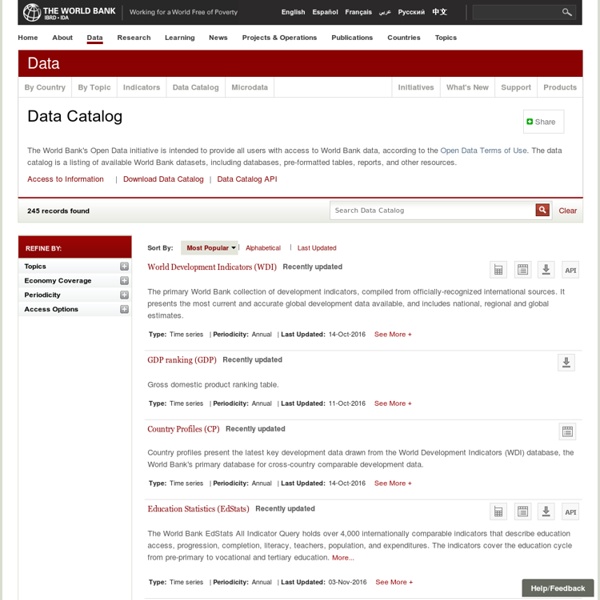Economic Data freely available online
Compiled by John Sloman, Economics Network Last updated 12th April 2014 Here are some links that you may find useful for accessing statistics and other information. Datasets that require you to pay or register are on a separate page along with pointers. (Note that some free datasets that require registration are also listed below.) Printing out this page If you print out this page, the URLs will appear alongside each individual link.
Public Data Sets on Amazon Web Services (AWS)
Click here for the detailed list of available data sets. Here are some examples of popular Public Data Sets: NASA NEX: A collection of Earth science data sets maintained by NASA, including climate change projections and satellite images of the Earth's surfaceCommon Crawl Corpus: A corpus of web crawl data composed of over 5 billion web pages1000 Genomes Project: A detailed map of human genetic variation Google Books Ngrams: A data set containing Google Books n-gram corpusesUS Census Data: US demographic data from 1980, 1990, and 2000 US CensusesFreebase Data Dump: A data dump of all the current facts and assertions in the Freebase system, an open database covering millions of topics The data sets are hosted in two possible formats: Amazon Elastic Block Store (Amazon EBS) snapshots and/or Amazon Simple Storage Service (Amazon S3) buckets. If you have any questions or want to participate in our Public Data Sets community, please visit our Public Data Sets forum .
logTool: Revealing the Hidden Patterns of Online Surfing Behavior
logTool [onformative.com] is a data visualization tool that displays your online activity, based on data from the powerful network packet sniffing tool Carnivore. By analyzing the different IP addresses and ports, the visualization is able to determine and represent what kind of application or service sends or receives the packets. Developed for the magazine Weave, logTool was used to digest the surfing behavior of several interaction designers, artists and developers.
Weave Data Tutorial
Weave Data TutorialTutorial for Weave Magazine 03.10 about visualizing network data Client: Weave Magazine / Page publisher We all use twitter, write emails, skype and blog all day long.
Live map of London Underground trains
Loading... Powered by Leaflet — Map tiles © Thunderforest, data © OpenStreetMap contributors. Live London Underground map
Protovis
Protovis composes custom views of data with simple marks such as bars and dots. Unlike low-level graphics libraries that quickly become tedious for visualization, Protovis defines marks through dynamic properties that encode data, allowing inheritance, scales and layouts to simplify construction. Protovis is free and open-source, provided under the BSD License. It uses JavaScript and SVG for web-native visualizations; no plugin required (though you will need a modern web browser)! Although programming experience is helpful, Protovis is mostly declarative and designed to be learned by example.
Visualizing Databases
I’ve become quite the fan of Gephi, lately, and received a good-natured challenge by one of my colleagues, which went something like, “Why is a everything a network with you, now?” Obviously, in the case of social network-like phenomena, such as mapping collaboration in the Digital Humanities with the DH@Stanford graph–network theory and network language (whether visual or theoretical) make sense. Network analytical tools like Gephi are also only a short step away from spatial analytical tools, like ArcGIS, many of which are used to ask questions about geographic networks and not about the kind of continuous data found in topography. Tooling Up for Digital Histories as part of the DH@Stanford graph, which describes collaboration as temporally-aware instances of interconnected social networks at Stanford University.
Airport and airline data
Navigation: Airport | Airline | Route | Schedule | Other | License Airport database (click to enlarge)



